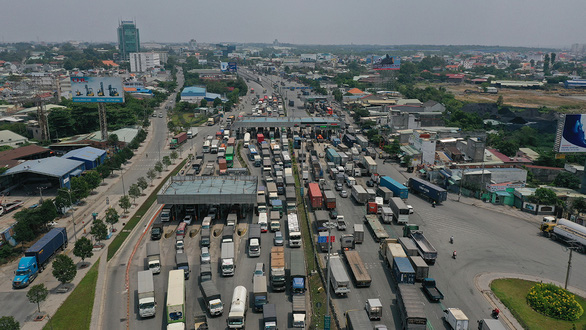
During a discussion with Tuoi Tre (Youth) newspaper on November 20, Tran Hoang Ngan, head of the Ho Chi Minh City Institute for Development Studies, blamed weak transport infrastructure in the southeastern region in general and in the city in particular for high logistics costs.
Ho Chi Minh City and the southeastern region should have solutions to the issue as soon as possible, Ngan advised.
Why has such an important economic area as the southeastern region yet to realize its inherent potential? Why have issues like high logistics costs, traffic congestion, and flooding remained unsolved over the years?
The southeastern region is a dynamic economic region with sustainable growth. It always takes the lead for industrialization and modernization of the country. However, from 2012 to now, five provinces and Ho Chi Minh City in the southeastern region have not been able to realize their potentialities, with development even slowing down in recent years.
In my opinion, traffic infrastructure investment in the area fails to match the regional potential. Traffic investment targets in the region lag behind the regional infrastructure planning until 2020 that the prime minister already approved. The network connecting the entire region by road, railway, and waterway has not been completed.
The sluggish completion of such projects as Ring Road 3 and Ring Road 4 in Ho Chi Minh City, the Bien Hoa – Vung Tau Expressway, and the Ben Luc – Long Thanh Expressway has led to great obstacles in travel and transportation. Most of the projects for waterway and railway links between the five provinces and the city are still on paper.
The system of seaports and roads connecting to the ports has not been properly developed. This has led to traffic problems, high transportation costs, and low competitiveness.
Meanwhile, investment from the state budget and state expenditures in the region remains low, despite its contribution of 40 percent of the national GDP and 40 percent of the total state budget revenue each year.
It is not to mention that the southeastern region accounts for more than 60 percent of overall exports.
But the rate of state budget spending for the region has fluctuated from 24 percent to 25 percent of the total state budget revenue from 2016 to now.
So, in order to create the impetus for the southeastern region’s inter-province development, what mechanisms and policies are needed to solve the above problems?
It is to increase the state budget expenditure rate for Ho Chi Minh City and the southeastern provinces. The provinces and city together have policies to allocate and use capital effectively, to avoid loss and waste. There should be, if possible, a mechanism that allows one province to finance another in the region for a transport connection project. Most importantly, we should determine that roads connecting the region should use the central budget while the inter-province links should use the regional budget.
How should we do for effective investment in infrastructure for regional links?
As the need to invest in infrastructure is huge for the whole region, we must prioritize investment in areas with the highest profitability and the ability to generate capital flows for later investment in remote areas.
We should focus on the potential of each locality to have an accurate and reasonable investment plan. For instance, Dong Nai and Binh Duong Provinces thrive in production and export, Ba Ria – Vung Tau is oriented toward services, and Ho Chi Minh City leans on finance.
The EU – Vietnam Free Trade Agreement officially came into effect, helping our country’s production and export activities become more competitive. Therefore, it is very necessary to pour a reasonable investment for the synchronous development of infrastructure connection in this period.
We should not spread investment in many fields at a time, but focus on traffic planning and key projects with priority. Instead of new projects, we should concentrate all resources on pending ones, such as the Ben Luc – Long Thanh Expressway.
Traffic connection between the southeastern region and 13 localities in the Mekong Delta region should also be prioritized, with great importance being attached to the Ho Chi Minh City – Moc Bai Expressway, the Ben Luc – Long Thanh Expressway, bridge projects connecting Ho Chi Minh City, Dong Nai Province, and Long An Province, and roads to seaports. At the same time, we should invest in local infrastructure in each locality. That way, synchronous infrastructure and comprehensive development are ensured.
For some projects, it is recommended to create favorable conditions to attract private capital. Recently, private firms have participated in infrastructure projects and they have set good examples. For instance, in Binh Duong Province, a series of infrastructure projects have been effectively implemented by private sectors such as My Phuoc – Tan Van Road connecting Ho Chi Minh City and Binh Duong, National Highway 1K, Bau Bang Industrial Park, Hanoi Highway connecting Ho Chi Minh City and Dong Nai, Tan Van Intersection, and My Phuoc – Bau Bang Road.
However, it is necessary to review the capacity of private investors, not to lead to the shortage of capital while the infrastructure remains unfinished.
In your opinion, what mechanisms and policies are needed for the cooperation between the southeastern provinces and city for more sustainable development?
In order for the southeastern region to develop sustainably, it is essential to build up a regional working mechanism, in which localities share with each other budget revenues and even growth, while targets are not set for each locality, but for the region as a whole.
The localities will no longer compete with each other but team up to attract foreign investment. For example, Ho Chi Minh City, Binh Duong, and Ba Ria – Vung Tau will help each other move on while developing their own strengths, instead of establishing rivalry.
The government should support this working mechanism by issuing decrees, laws or by-law documents.
According to Bui Van Quan, chairman of the Ho Chi Minh City Goods Transportation Association, freight is high because transport companies have to pay many types of cost. Meanwhile, transport productivity is limited and transport infrastructure is inadequate.
Transportation costs usually include 12 items, of which fuel costs account for 30-35 percent, tolls make up 10-15 percent, driver wages add up to 15 percent, in addition to vehicle maintenance and other additional costs. Therefore, transportation costs are high, leading to high market prices, and thus, a reduction in competitiveness.
According to the Vietnam Logistics Business Association, logistics costs make up 16.8-17 percent of the national GDP, equivalent to about US$42 billion in size. Logistics costs in Vietnam are considered more expensive than other countries in the region.







